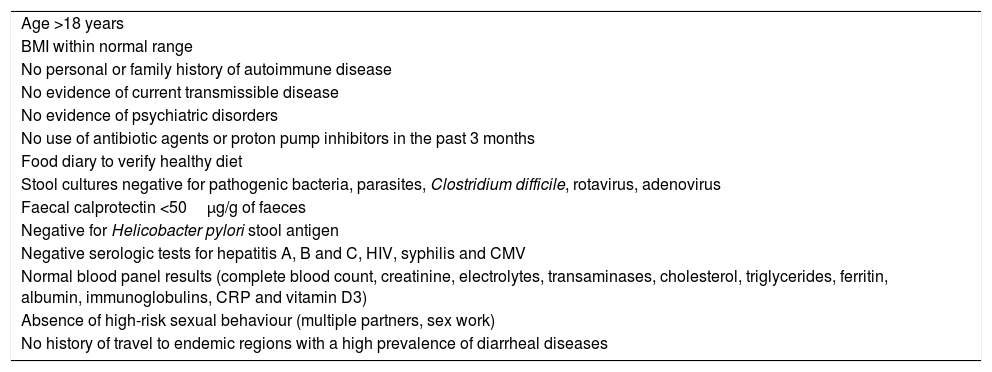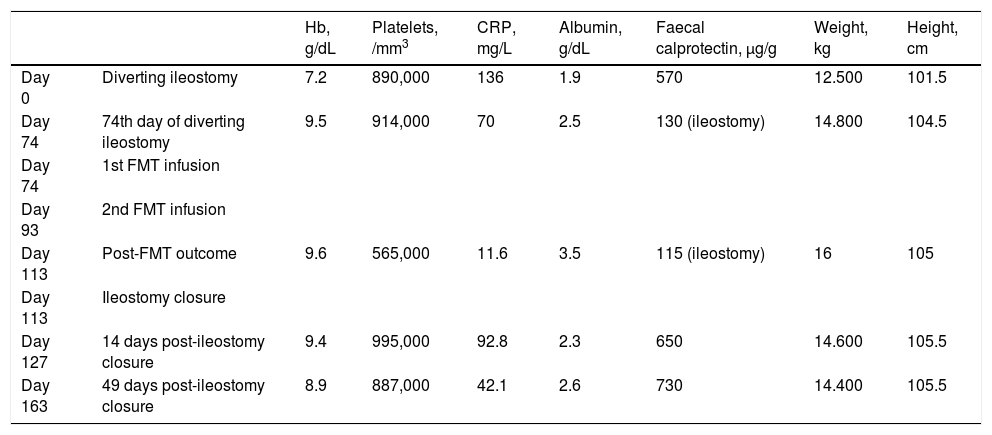The intestinal dysbiosis found in patients with inflammatory bowel disease (IBD) has partly guided the development of treatment strategies. Faecal microbiota transplantation (FMT), which consists in the infusion of a faecal suspension from a healthy donor into the gastrointestinal tract of a recipient to cure a specific disease associated with changes in the intestinal microbiota, has proven efficient in the treatment of recurrent infection by Clostridium difficile in adults and children. This treatment modality could also contribute significantly to the control of IBD. Diverting ileostomy is a surgical intervention that has been used as a temporising therapy in children with refractory colitis to stabilise symptoms, improve nutritional status and taper or discontinue steroid therapy.1 We describe the first paediatric case of FMT via diverted ileostomy performed in Spain.
The patient was a boy aged 6 years and 7 months whose mother had Crohn disease. He had received a diagnosis of inflammatory bowel disease unclassified (IBDU) at age 2 years based on a history of recurrent episodes of bloody diarrhoea, anaemia and hypoalbuminaemia. Tests for the differential diagnosis of immunodeficiencies and monogenic inflammatory diseases were negative, and diagnostic tests for detection of infection including tuberculosis and cytomegalovirus were repeatedly negative, except in the assessment of 3 episodes of bloody diarrhoea, when the patient tested positive for C. difficile toxin. Three endoscopic examinations with histological examination of biopsy specimens did not provide significant findings that would allow the diagnostic classification of colitis. The patient did not respond to conventional treatment with mesalamine, systemic steroids, thiopurines and infliximab (with drug level monitoring revealing levels within the normal range for both). With the agreement of the family, the decision was made not to perform a colectomy, opting for the alternative of diverting ileostomy, and scheduling a FMT via the inferior stoma before closure of the ileostomy. The family provided informed consent, and the clinical ethics board of the hospital approved the procedure. Stringent criteria for donor selection were applied with the aim of preventing or reducing the severity of potential donor-related events in the recipient (Table 1).
Donor screening criteria.
| Age >18 years |
| BMI within normal range |
| No personal or family history of autoimmune disease |
| No evidence of current transmissible disease |
| No evidence of psychiatric disorders |
| No use of antibiotic agents or proton pump inhibitors in the past 3 months |
| Food diary to verify healthy diet |
| Stool cultures negative for pathogenic bacteria, parasites, Clostridium difficile, rotavirus, adenovirus |
| Faecal calprotectin <50μg/g of faeces |
| Negative for Helicobacter pylori stool antigen |
| Negative serologic tests for hepatitis A, B and C, HIV, syphilis and CMV |
| Normal blood panel results (complete blood count, creatinine, electrolytes, transaminases, cholesterol, triglycerides, ferritin, albumin, immunoglobulins, CRP and vitamin D3) |
| Absence of high-risk sexual behaviour (multiple partners, sex work) |
| No history of travel to endemic regions with a high prevalence of diarrheal diseases |
BMI, body mass index; CMV, cytomegalovirus; CRP, C-reactive protein; HIV, human immunodeficiency virus.
The procedure involved the preparation of a suspension of fresh donor faeces, which had been produced 3h prior and stored at room temperature in a sterile container. In the hospital laboratory, a 50g sample of the fresh faeces was blended in 150mL of nonbacteriostatic physiological saline, the slurry filtered, and the resulting suspension collected in a sterile container. A sterile syringe was used to deliver 50mL of the faecal suspension through the inferior stoma of the ileostomy. The patient remained in the supine position for 2h after transplantation. Twenty days later, the patient underwent a second transplantation of faecal matter from the same donor following the same procedure. The patient tolerated the intervention very well. Table 2 describes the progress of the patient after transplantation.
Patient progress.
| Hb, g/dL | Platelets, /mm3 | CRP, mg/L | Albumin, g/dL | Faecal calprotectin, μg/g | Weight, kg | Height, cm | ||
|---|---|---|---|---|---|---|---|---|
| Day 0 | Diverting ileostomy | 7.2 | 890,000 | 136 | 1.9 | 570 | 12.500 | 101.5 |
| Day 74 | 74th day of diverting ileostomy | 9.5 | 914,000 | 70 | 2.5 | 130 (ileostomy) | 14.800 | 104.5 |
| Day 74 | 1st FMT infusion | |||||||
| Day 93 | 2nd FMT infusion | |||||||
| Day 113 | Post-FMT outcome | 9.6 | 565,000 | 11.6 | 3.5 | 115 (ileostomy) | 16 | 105 |
| Day 113 | Ileostomy closure | |||||||
| Day 127 | 14 days post-ileostomy closure | 9.4 | 995,000 | 92.8 | 2.3 | 650 | 14.600 | 105.5 |
| Day 163 | 49 days post-ileostomy closure | 8.9 | 887,000 | 42.1 | 2.6 | 730 | 14.400 | 105.5 |
CRP, C-reactive protein; FMT, faecal microbiota transplantation; Hb, haemoglobin.
The case presented here is relevant in part due to the performance of diverting ileostomy in a child with severe colitis refractory to treatment, a technique that was recently described by Maxwell et al.1 for treatment of this type of situation. We did observe clinical improvement in our patient, with significant recovery of body weight and a moderate decrease in CRP. Once the patient had stabilised, FMT was performed with the aim of amplifying the benefits of treatment. There is still very little data on the use of FMT in paediatrics, especially for treatment of IBD. On the other hand, there are substantial methodological differences between published studies, which makes it difficult to draw valid conclusions. We are not aware of any previous publication reporting the delivery of the faecal suspension via ileostomy in paediatric patients. Although there is no consensus on the optimal delivery route, the evidence suggests that infusion via colonoscopy is superior to retention enema and the nasogastric and nasoenteric routes, not only because of patient acceptance but also because it achieves infusion of the entire colon.2 In our case, we considered that FMT through the stoma of the ileostomy offered the best possible conditions, as direct delivery of the faecal suspension to the terminal ileum guaranteed the gradual passage through the entire colon. After 2 infusions, there was a very satisfactory improvement of symptoms, probably due to the additive beneficial effects of ileal diversion and FMT. Few paediatric studies have been published on the use of FMT in children with colitis in the context of IBD, and their results are contradictory. In our case, unlike the studies mentioned above,3–6 the suspension was delivered by direct infusion to the distal ileum and not via enema, colonoscopy or nasoenteric tube, as direct infusion probably increases the chances of anterograde deposition of the infusion at the colonic level, avoiding potential interferences during the gastrointestinal transit. Unfortunately, we are unable to present favourable outcome data for our patient. We do not know how many infusions of faecal solution he may have needed. Performance of randomised clinical trials in children is of the essence in order to clarify the numerous doubts we have at present.
Please cite this article as: Sierra Salinas C, Vicioso Recio MI, Blasco-Alonso J, Serrano Nieto MJ, Navas-López VM. Trasplante de microbiota fecal en niño con enfermedad inflamatoria intestinal de inicio muy precoz. An Pediatr (Barc). 2018;89:184–186.






